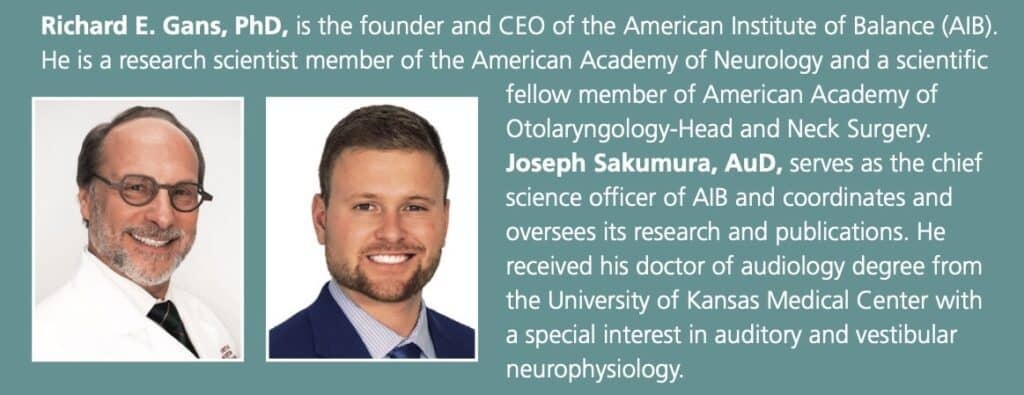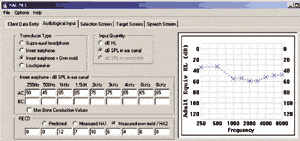When searching for opportunities to grow revenue, the evaluation and management of balance disorders will be strong for years to come.
Hearing Aid | April 2023 Hearing Review
By Richard E. Gans, PhD, and Joseph Sakumura, AuD
Every year, 90 million Americans seek help for dizziness, vertigo, and fear of falling, meaning there is a huge need for practitioners providing diagnostic services. It’s no wonder then that audiology and otolaryngology practitioners often ask the question: How do you build a diagnostic balance service within a practice? And how do we provide much needed care to patients with a wide variety of equilibrium conditions while being fiscally sound?
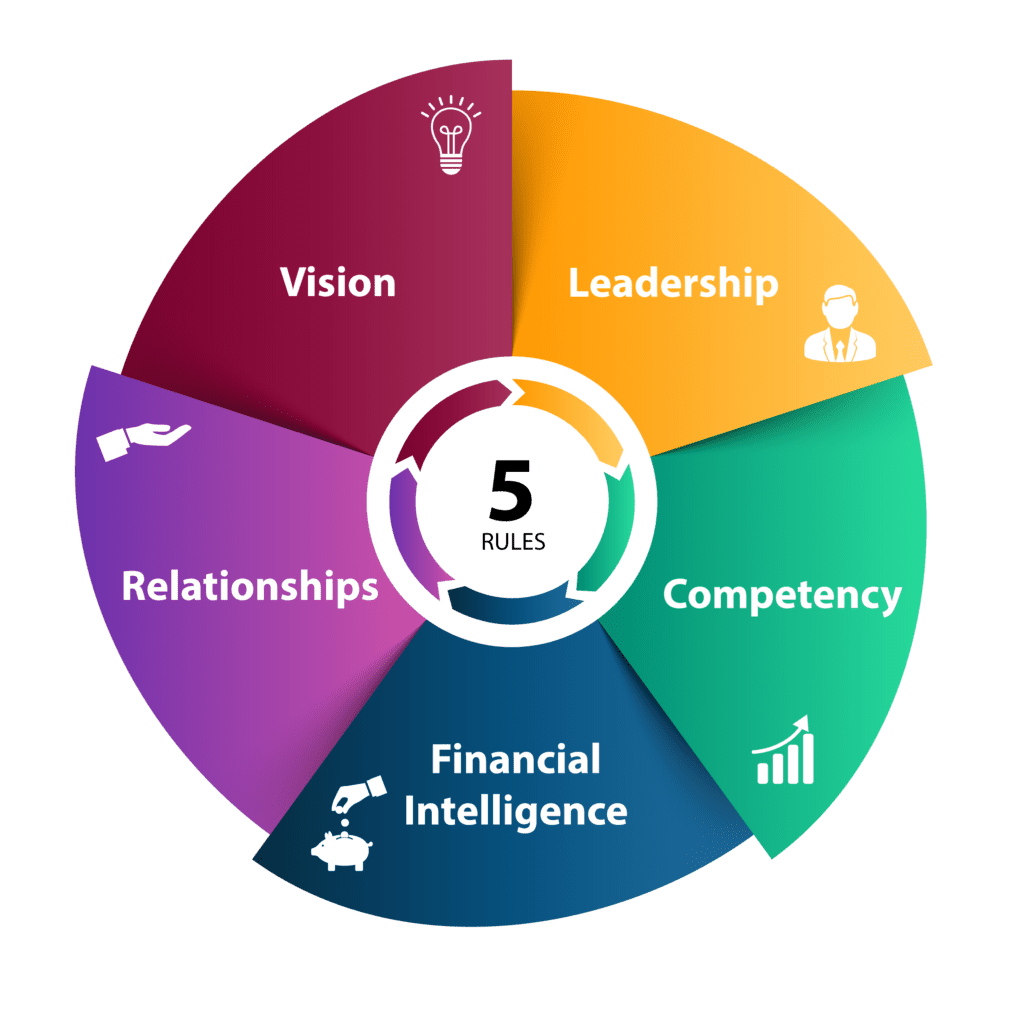
For more than 30 years, the first author has worked exclusively in diagnostic and rehabilitation vestibular and balance services. Together, we, the authors of this article, have found that the success of a diagnostic balance practice can best be attributed to following five rules, as illustrated in Figure 1. In this article, we will break down each of those rules and provide action items to help audiology and otolaryngology practitioners like yourself set up a successful and fiscally sound practice.
Vision
“Successful people move on their own initiative, and they know where they are going before they start.” – Napoleon Hill
1. Decide what your vision is before you start. Is it to diversify your practice, build new medical referral sources, and add new revenue? If you are dispensing, what is the strategy to increase your current units per month by offering this new service? What diagnostic services will you include, understanding that you need not offer every test and can roll them out at your own pace. Or perhaps your vision is to become the major player and category killer in your region with full-diagnostic capabilities in multiple locations. There is no one best decision. It’s your vision, no one else’s.
2. Determine what is presently avail- able in your area and what could you add or do better. Is there a facility that performs VNG but has no rotary chair, vHIT, or VEMP? This may provide a strategy for you to create a competitive advantage. The idea of just adding another VNG test and thinking that will then mark you as superior to another facility in town will be a hard sell. It’s unlikely to be enough to motivate a referral source to change and start recommending your facility over an established one. It simply becomes a “me too” proposition. If there are presently no vestibular services being offered in your community, then introducing a video-goggle and fall-risk screening protocol or treatment for BPPV may be a good start.
Leadership
“Everything rises or falls on leadership.” – John Maxwell
1. Your team looks to you as an example. Your behaviors set the tone. In order for them to follow your vision and direction they must have buy in. They should understand the mission and that all oars must be in the water and rowing in the same direction. Peter Drucker, in his 1954 groundbreaking book, Practice Management, wrote, “[The worker] should know how his work relates to the work of the whole. He should know what he contributes to the enterprise … if he lacks information, he will lack both incentive and means to improve his performance … It is in the best interest of the organization that the worker has the information.”
Your team members should understand the role their position plays in the organization. Do not be afraid to discuss the economics of their role. This is critically important when discussing compensation and the financial goals of the individual and the practice. It avoids a team member’s subjective belief in what their salary should be and provides objective milestones and goals.
2. Become a coach and mentor to your team. Telling a clinical team member what you want them to do, without providing the rationale and showing them how it’s done, and with enthusiasm, is rarely successful. For example, stating that all patients must have cervical VEMPS performed without the team member fully understanding the diagnostic importance and how to administer the test will result in poor and non- standardized care in your facility and lost revenue, as they likely won’t do it.
3. Build a championship team. This requires that everyone onboard is aligned with the owner’s/manager’s vision and works together and this includes everyone from front office staff to senior clinicians. The fastest way for an owner/manager to lose the respect of his or her team is to tolerate bad or insubordinate behavior to the chagrin of the rest of the team.
4. Demonstrate through your actions. You must show that your team’s personal, professional, and financial success matters.
Competency
If you spend an extra hour each day of study in your chosen field you will be a national expert in that field within five years or less.” – Earl Nightingale
1. Be a lifelong learner and read, read, read! New information is published every month in professional journals across a number of specialties. Do not assume the only important articles or breakthroughs will be in the audiology and otolaryngology publications. You couldn’t possibly have learned everything you need to know in school, and even then it was likely superficial and less than comprehensive.
2. Become a recognized expert in your community. Referring practitioners do not respect the degree nor the school you attended, until they respect the knowledge you have in the service of caring for their patients.
3. Identify mentors, including specialists, in your community with whom to consult. No one ever achieved anything great alone. There are physicians, therapists, and audiologists from whom you can gain invaluable wisdom on medical and psychiatric conditions, rehabilitation strategies, and patient management. Open yourself to all sources of new knowledge.
4. “Step away from the ear.” Develop interdisciplinary interests and resources. The majority of equilibrium conditions are not ear related. Consider all the physical and psychological manifestations of your patients’ conditions. Take nothing for granted.
5. Recognize that human equilibrium is a “birth to earth” clinical science, providing your practice limitless opportunity. The human vestibular mechanism is fully developed. Embryologically, the peripheral vestibular system is fully formed at only 49 days of gestation. There are over 500 known syndromes and mitochondrial disorders with vestibular expressivity. Infants and children with or without hearing loss may present with delayed maturational motor milestones and have abnormal vestibular function. Meanwhile, the aging process affects all aspects of equilibrium. We walk on our legs, not our ears. Always consider the status and integrity of a patient’s visual, neurological, biomechanical, and neuromuscular systems.
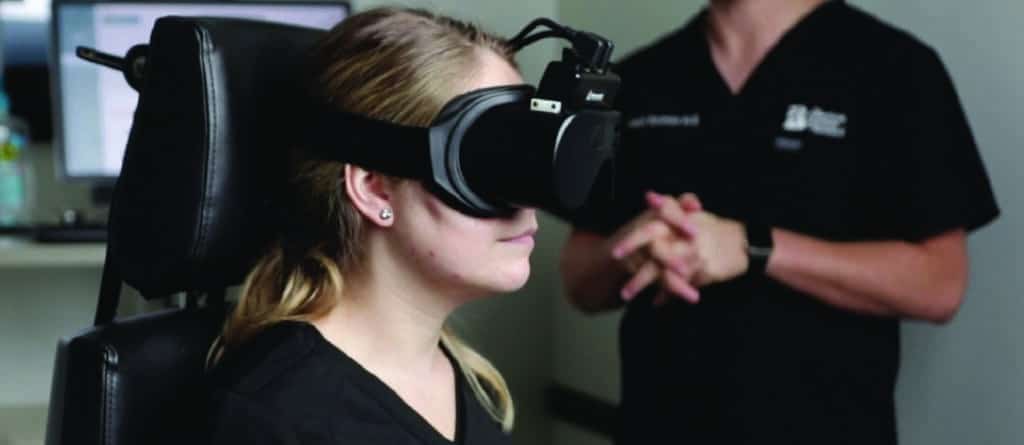
Relationships
“To have a friend, you must be one.”- Ralph Waldo Emerson
1. Avoid “baby bird syndrome.” Do not act like a baby bird sitting in a nest waiting to be fed, asking for referrals, but offering nothing in return. Build two-way referral relationships with other practitioners.
2. When reaching out to potential referral sources, ask about how they manage their dizzy or high-risk fall patients. What is their belief system about dizzy patients? What are they doing now for these patients? Include primary care and specialists in cardiology, endocrinology, rheumatology, etc., in addition to otolaryngologists and neurologists who will have a better initial understanding. Prepare yourself for the task of the lift, the time, the energy, and the resources needed to educate referral sources on the importance of diagnostic balance services. Build real and meaningful relationships with referral sources that are value based; become a colleague.
3. Avoid being perceived as a transactional professional. Your availability, accessibility, and willingness to go that extra mile for referring practitioners and their patients will pay dividends for years. As Theodore Roosevelt said, “No one cares what you know, until they know how much you care.” Work in that extra patient during lunch or after 5:00 pm. Be willing to see a patient who has no insurance at no or a reduced charge for a physician who asks. The physician has hundreds of patients who do have insurance coverage. This is a gesture of goodwill which will be rewarded in referrals for years to come.
4. Create and promote an interdisciplinary continuum of care to serve all patients, pediatric to geriatric. Considering that the majority of patients other than those with BPPV, vestibular neuritis, or Meniere’s will have non-otologic conditions, you will need collaborative relationships with specialists and physical and occupational therapists who will be essential to your patients’ progress through a continuum of care. These practitioners will also become sources of knowledge and great assistance in your own growth as a balance expert.
Financial intelligence
1. Work with CPA accountants, tax advisors and attorneys to be sure you are receiving the best advice. Keep these relationships current and use them as strategic partners. Discuss your plans with them before you act. If you are an LLC or S-Corp, there will be many tax advantages for your personal tax filing in purchasing diagnostic equipment. Look at the corresponding reimbursement for the CPT codes associated with each diagnostic protocol.
2. Accept insurance. Are you a provider for Medicare and/or the majority of insurance carriers in your area? If not, get to work and obtain your credentials. Without this, your venture will have a poor foundation. Do this months before you sign a lease or buy any equipment.
What’s more, learn about the health insurance payers in your area. Look at contracts, be sure to have an addendum listing the CPT codes you will be performing and the agreed upon reimbursement amounts. Find out what is the penetration of payers by type, especially Medicare Advantage Plans? Speak with friendly physicians and their practice managers to ask for introductions or contact information for insurance plans that you wish to sign-on to. They can help you avoid obstacles of getting through to the right person or decision makers.
3. Be prepared to wait for payment.
Unlike with a cash-based dispensing model, if you accept insurance, be prepared to wait for payment ranging from 2 weeks for traditional Medicare to 60 days for other insurance payers. Many insurers will require pre-authorizations, so have a staff that has experience in medical billing and find EMR systems that can provide you proper reports on billing, payments, and an account aging report.
4. Review the Explanation of Medical Benefits (EOMB) for those payments from the insurers every month with your billing specialist. Are you receiving the correct reimbursement that you’ve negotiated in contracts? Are there problem insurers that you may want to stop accepting? Have payments changed? If they are lower, find out why.
5. Evaluate the individual billing practices of your clinical staff. Are there clinical team members that consistently bill lower than the rest of the team? If so, they are a problem and this needs to be addressed. Are they consistently not performing or billing DPOAE or BAER? If so, why aren’t they following the organization’s policy and protocols? Coach them back into compliance and have them work with the clinic’s superstars. Create the expectations and then monitor their performance with their understanding that this is the standard for care.
6. Consider providing a contract service model outside your own four walls, to hospitals, multi-specialty physician groups, and otolaryngology and neurology practices. This model offers many advantages, and it may also operate alongside them with a direct service model.
7. Stay humble, stay hungry. No one would have believed that retail powerhouses like K-Mart or Sears would just disappear. But they did. Once the word is out that you are successful, others may begin to look at becoming your competitor. Stay open to new ideas, better ways of managing and promoting your business, and expansion. Create a strong foundation that can foster long-term growth and success.
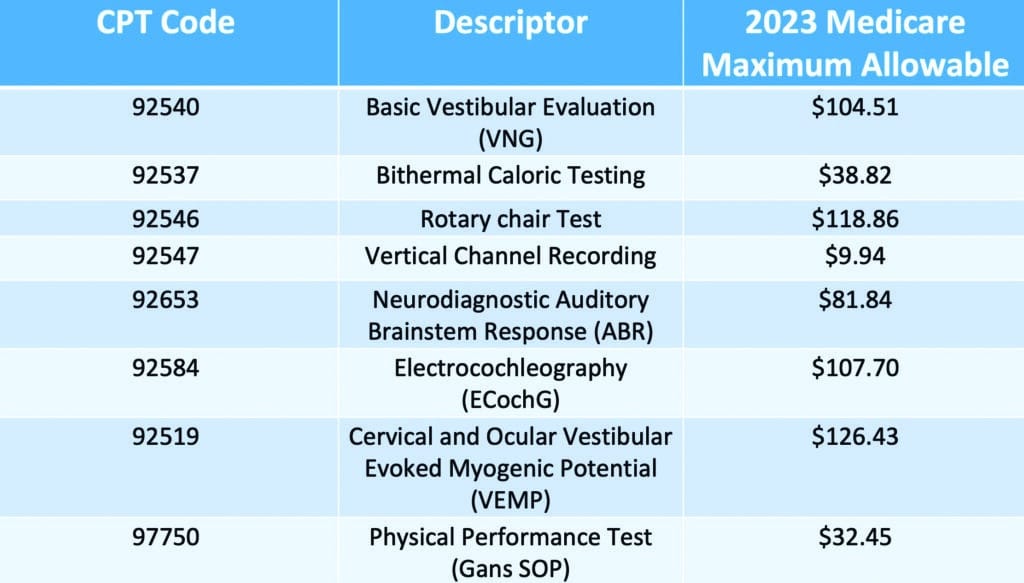
Summary
Today, when otolaryngology and audiology practices are searching for opportunities to grow revenue, and avoid the competition seen in the hearing aid space from manufacturers, online vendors, or big box competitors, this is the perfect time to consider adding diagnostic balance services. Opportunities to succeed in the evaluation and management of balance disorders will be strong for many years to come. The need is great, reimbursement is excellent (the cost: value ratio of equipment and time to test is shown by CPT codes in Table 1). With robust planning and execution of a good business plan, audiology and otolaryngology professionals who seek to fulfill this need will have great success. Ultimately, in the world of diagnostic and rehabilitation medicine, success is not driven by hope but by knowledge and strategy.
